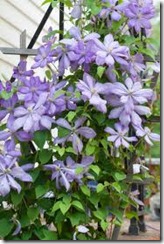Clematis are versatile landscaping plants that climb up fence wires and trellises. Hundreds of varieties exist; some have flat, large flowers while others have bell-shaped flowers. Several fall-bearing varieties produce prolific clusters of 1-inch flowers. Colors range from white and cream to hot pink, variegated or vivid purple and blue. Bloom times vary depending on the variety from early summer through fall. The most common reason a clematis isn’t blooming is due to improper pruning, although disease and soil conditions may also play a part.
Pruning Methods
-
When and how to prune clematis is often a source of confusion because different varieties require different pruning methods. Nurseries may label clematis plants to aid gardeners as follows: Prune plants labeled with a "1" or "A" in early spring to remove dead wood only. These plants bloom on old wood, so wait until after they’ve bloomed to prune them more severely. Prune plants labeled with a "2" or "B" similarly. These plants bloom on both old and new wood. Prune plants labeled with a "3" or "C" back 12 to 24 inches high in early spring. Most of these types bloom mid-to-late summer and are vigorous growers. Without hard pruning, they become a tangled mess.
Growing Conditions
-
Clematis need full-sun to bloom, but prefer moist, cool, well-drained soil. Plant them in soil that has been amended with compost to improve drainage. Add lime to the planting hole if your soil has a pH level below 7.0. Place a 3- to 4-inch layer of wood chip mulch on the soil to keep it cool and water it at least weekly to keep the soil moist.
Bloom Time
-
Clematis bloom at variable times throughout the summer, depending on the variety. Perhaps your clematis isn’t blooming in early to midsummer because it’s a fall-blooming variety, such as Sweet Autumn Clematis (C. terniflora) and Texas Clematis (C. texensis). Continue to care for it as you normally would.
Disease
-
The most common clematis disease is clematis wilt, which causes a fungal root rot and leaf spot. The plant may appear fine, and then turn black and wilted within a few days. Poorly-drained soils aggravate this problem. Remove and destroy any diseased plant parts and wait. The plant will probably grow back the following year.


Deprecated: strpos(): Passing null to parameter #1 ($haystack) of type string is deprecated in /home/agriviek8Qv/agriviet.net/public_html/wp-includes/comment-template.php on line 2522